Cite this document
(Financial Analysis by Using Ratios: Bloodstone Ltd Case Study, n.d.)
Financial Analysis by Using Ratios: Bloodstone Ltd Case Study. Retrieved from https://studentshare.org/finance-accounting/1542698-financial-management-ratios-comparision
Financial Analysis by Using Ratios: Bloodstone Ltd Case Study. Retrieved from https://studentshare.org/finance-accounting/1542698-financial-management-ratios-comparision
(Financial Analysis by Using Ratios: Bloodstone Ltd Case Study)
Financial Analysis by Using Ratios: Bloodstone Ltd Case Study. https://studentshare.org/finance-accounting/1542698-financial-management-ratios-comparision.
Financial Analysis by Using Ratios: Bloodstone Ltd Case Study. https://studentshare.org/finance-accounting/1542698-financial-management-ratios-comparision.
“Financial Analysis by Using Ratios: Bloodstone Ltd Case Study”, n.d. https://studentshare.org/finance-accounting/1542698-financial-management-ratios-comparision.


